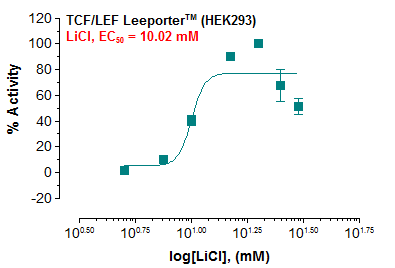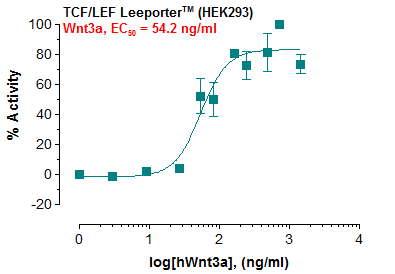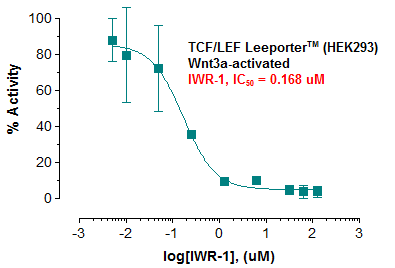TCF/LEF Leeporter™ Luciferase Reporter-HEK293 Cell Line
Catalogue Number: 14-119ACL-ABO
| Manufacturer: | Abeomics |
| Type: | Cell Lines |
| Shipping Condition: | Dry Ice |
| Storage Condition: | Liquid N2 |
| Unit(s): | 1 vial |
| Application: | FA |
Description
Description: The TCF/LEF Leeporter™ Luciferase Reporter cell line is a stably transfected HEK293 cell line which expresses Renilla luciferase reporter gene under the control of the TCF/LEF response element. This cell line is designed to monitor the transcriptional activity of TCF/LEF and can be used for studying Wnt signaling pathways as well as screening of activators or inhibitors that affect the TCF/LEF transcriptional activity.
Additional Text
Application Notes
Application: Monitor the TCF/LEF induction activity. Screen for activators or inhibitors of the TCF/LEF signaling pathway. Culture conditions: Cells should be grown at 37°C with 5% CO2 using DMEM medium (w/ L-Glutamine, 4.5g/L Glucose and Sodium Pyruvate) supplemented with 10% heat-inactivated FBS and 1% Pen/Strep, plus 3 µg/ml of Puromycin (Note: Puromycin can be omitted during the reporter cell assays). It is recommended to quickly thaw the frozen cells upon receipt or from liquid nitrogen in a 37°C water-bath, transfer to a tube containing 10 ml of growth medium without Puromycin, spin down cells, resuspend cells in pre-warmed growth medium without Puromycin, transfer resuspended cells to T25 flask and culture in 37°C-CO2 incubator. Leave the T25 flask in the incubator for 1~3 days without disturbing or changing the medium until cells completely recover viability and become adherent. Once cells are over 90% adherent, remove growth medium and passage the cells through trypsinization and centrifugation. At first passage, switch to growth medium containing Puromycin. Cells should be split before they reach complete confluence. To passage the cells, detach cells from culture vessel with Trypsin/EDTA, add complete growth medium and transfer to a tube, spin down cells, resuspend cells and seed appropriate aliquots of cells suspension into new culture vessels. Subcultivation ration = 1:10 to 1:20 weekly. To achieve satisfactory results, cells should not be passaged over 16 times. Functional validation: A. Response of TCF/LEF Leeporter™ - HEK293 cells to lithium chloride (LiCl) (Figure 1). 1. Harvest TCF/LEF Leeporter™ - HEK293 cells and seed cells into a white solid-bottom 96-well microplate in 100 µl of growth medium at 5 x 10^4 cells/well. 2. Incubate cells at 37°C in a CO2 incubator for overnight. 3. The next day, stimulate cells with various concentrations of LiCl. 4. Incubate at 37°C in a CO2 incubator for 16 hours. 5. Equilibrate the plate to room temperature for 10 minutes. 6. Add 50 µl of luciferase assay reagent (Abeomics, Cat #17-1101; Refer to the reagent datasheet for the detailed luciferase assay protocol) per well. 7. Read the plate in 1-5 minutes to measure luminescence using a microplate luminometer. B. Response of TCF/LEF Leeporter™ - HEK293 cells to Wnt3a (Figure 2). 1. Harvest TCF/LEF Leeporter™ - HEK293 cells and seed cells into a white solid-bottom 96-well microplate in 100 µl of growth medium at 5 x 10^4 cells/well. 2. Incubate cells at 37°C in a CO2 incubator for overnight. 3. The next day, stimulate cells with various concentrations of human Wnt3a in the presence of 10 mM LiCl. 4. Incubate at 37°C in a CO2 incubator for 16 hours. 5. Equilibrate the plate to room temperature for 10 minutes. 6. Add 50 µl of luciferase assay reagent (Abeomics, Cat #17-1101) per well. 7. Read the plate in 1-5 minutes to measure luminescence using a microplate luminometer. C. Inhibition of Wnt3a-induced TCF/LEF activity by IWR-1 in TCF/LEF Leeporte
Storage Note
Immediately upon receipt, store in liquid nitrogen.


